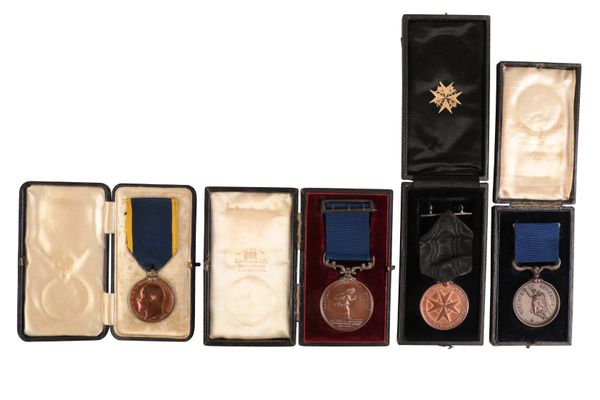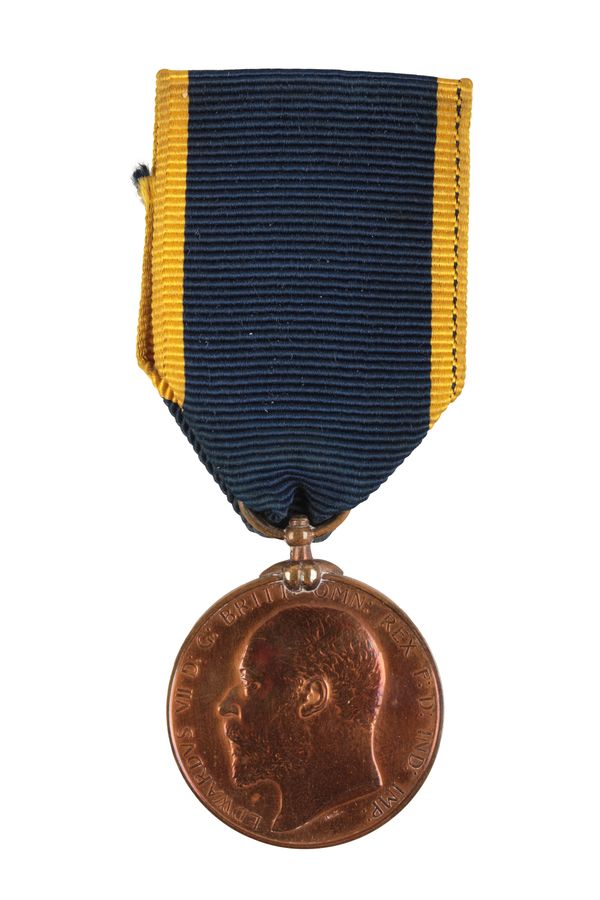who was decorated for his actions at the Pretoria Pit Disaster, during which 344 men and boys died, amongst them his son.
| Estimate: | £5,000 - £8,000 |
| Hammer price: | £5,000 |
Edward Medal for Mines, E.VII.R., 2nd Class in bronze, correctly engraved William Markland
Royal Humane Society Medal in Bronze, successful, correctly engraved William Markland 21st December 1910
Life-Saving Medal of the Most Venerable Order of the Hospital of St John of Jerusalem in bronze, engraved ' Presented to William Markland July 1911'
Bolton & District Humane Society Medal for the Hulton Colliery Disaster, unnamed as issued
Each medal is in the original box of issue.
Condition NEF
William Markland was born in Ashton - in- Makerfield, Wigan on the 17th of March 1853.
Starting as a Miner, by 1901, he had become a Colliery Fireman Below ground, his role was to oversee safe working practices and monitor the gas. He worked in Hulton Colliery Bank Pit No. 3 (Pretoria Pit), in Over Hulton, Westhoughton. In 1901, he was living at 126 Brancker Street, Westhoughton, with his wife Annie and their two sons, William Ewart Gladstone Jr and Robert.
On the 21st of December 1910, 345 workers, William Jr amongst them, were underground and at work in the No 3 bank pit shaft in the Plodder, Yard and Three-Quarters mines. At 7.50 am, a colossal explosion, thought to have been caused by a build-up of gas occurred.
The official report stated that the cause was a damaged safety lamp ignited methane gas, which triggered a coal dust explosion which caved in the roof. Three hundred forty-four men were killed, making it the second-worst mining disaster in England. William Jr was one of the men killed, he was only 17 years old.
Alfred Tongue, the manager of the pit and leader of the rescue efforts that day gave the following account to the court of enquiry:
I was in my house and heard the report about ten minutes to eight and was informed shortly after that there had been an explosion. When I got to the pit, I found smoke coming from the upcast shaft. I saw that a portion of the casing of the upcast shaft had been wrecked. I went forward to the downcast shaft and was informed by the mechanical engineer that one of the cages was fast in the shaft as a result of the explosion. There was no damage to the engine and as the No. 3 shaft was out of the purpose for travelling purposes, we set to work to liberate the cage in the downcast. Fortunately one of the cages appeared to be free, but it could not be brought up because the other cage was fast. We had to disconnect the rope from the cage that was fast from the drum and after that, the free cage was brought to the surface. I got to the pit about ten minutes past eight and the cage was free at about nine o’clock.
When we got the cage working took five men in the signal cage and went quietly down calling at the Trencherbone mine. Llewellyn Williams the undermanager of the Trencherbone mine was at the mouthing and I asked if all the men were all right there. He said, “Yes”. They had suffered from fumes but everything was clear. I took him with me in the cage and we went further down. On our way down we encountered obstacles in the shaft, broken signal wires and bearers, and we were in considerable alarm as to whether the cage was going to stick or not. But it kept freeing itself and broke through all the obstacles. We got to the Yard mouthing and, on going in, saw the underground fan blown inwards towards the downcast pit. Going forward through the electric haulage house, which was the main route to the upcast shaft bottom, we found great wreckage and got through into the No.3 pit bottom shunts where we found a boy. There was afterdamp and it was hot but we went forward. We picked up the boy and sent him back up the pit. Going forward we found Byres struggling, and we carried him to the cage. I looked about and found more dead bodies lying about, and then we decided to go down and see how the men in the Arley were. We first took the injured men up to the top and then set out immediately to go to the Arley mine. Having passed the Yard mine, I heard a shout, “Send the cage to the Yard mouthing” which was repeated mechanically over and over again. We had been at the Yard mouthing and I could not understand it, but I remembered that it would be the other Yard mouthing and we found the source of the noise. It was a lad from the workshops, Staveley. We got him out and lifted him up and asked him what he had been doing and were there any more. He said that here was a lad close to him, dead. We took him to the top and then went down into the Arley mine again having difficulty as the cage kept sticking and freeing itself. We called to the Three-Quarters mouthing in the shaft, which was not used, instead of going down the tunnel and getting to the Arley mouthing. We asked if they were all right and they replied that they were and wanted to go up. I said there were others in a worse position than they, and they must be patient.
When we got to the Arley, we found regular pandemonium. Men were crying to come up, they were ill with the fumes. Men with their comrades’ arms about them. Some were worse affected than others and the undermanager, John Bullough was amongst them calling upon them to be men and doing what he could. Do as we could we could not get quietness. I shouted to those round about, “Put those men who are ill in the cage, and the strong keep back!” I was afraid of panic and that the men would rush the cage and seize ropes or anything, but fortunately they did not. The men who were ill were put in the cage and taken to the top. I went with them and came back to the Yard taking others with me and sent the cage to the Arley to fetch another load. The Arley and the Trencherbone men were all got out safely and we soon had a fair number of the men down in the Arley rescuing.
Six of the Trencherbone men who had been in the cage at the Trencherbone mouthing when the explosion occurred, were raised to the surface after the suffering Arley men and the other Trencherbone men were all got out at last. It was all done with one cage, signalling by knocking on the cage, as the proper signalling apparatus had broken down. There was no mishap whatsoever in getting the whole of the 545 men out and we had them all out in three and a half hours.
After getting down into the Arley Mine again, I took a few men and went on the East level, where we found a fire at an air crossing. I left instructions for the fire to be put out and went forward with two men to the down brow. I also instructed Turton and Scott, two reliable men, to proceed a short distance to the Plodder tunnel to see if there were any fires and if so, to report. I then went forward down the down brow and at the bend of the brow, after calling out, heard a man respond. The man was able to give his name as Devonport. I gave him a drink and sent a man back for the doctor and a stretcher. Doctors Lee and Russell had come down with us in the cage. Devonport was carried out on the stretcher and taken to the surface. As the falls were so bad further on in the down brow, I decided to return to the pit, and it was there reported to me by Messrs. Turton and Stott that they had found a fire but had not been able to put it out. I asked them to return to it to do so but to be very careful of the fumes. I returned to the air crossing on the East level where the men were engaged in putting out a fire.
By this time Mr. Gerrard, H.M. Inspector of Mines and several mining engineers had arrived at the spot. It was decided to restore the air crossing. At about this time news was brought to me that Turton, the fireman who had been sent to put out the fire had been overcome by fumes. We did what was possible for him and he was sent to the surface. The next operation was the restoration of the air crossing over the No.1 East North Plodder, Top Yard, and Three-Quarters districts. After restoring this, the air crossing over the North Plodder Jig was restored. The only ventilation that was being affected in the mines was the natural ventilation combined with a little assisted ventilation, due to the continuous running of the Trencherbone fan, all the rest of the fans had been put out of action by the force of the explosion. The stand-by surface fan was intact, but the casing at the pit top was damaged and had to be put right.
This was completed early and the surface fan was ready to run in nine and a half hours after the accident. After restoring the air-crossing in the north Plodder Jig which gave the ventilation a chance to get into three important districts, I went along with the Inspectors and other engineers to consult with a Consultative Committee on the surface. It was decided not to put the fan into operation as there was still some doubt as to whether there was any fire in the mine. Returning down the mine, we again went into the down brow a fixed a tight cloth stopping in the brow with a view to forcing the air into the down brow workings. The finishing touches to this operation were affected by the men with “rescue” apparatus. Shortly after this, Mr. Gerrard, himself, and a few others decided to make an inspection of the Three-Quarters mine thinking it possible that a few of these men, being near the shaft, might be still living, and that it was possible to bring them relief. We went in at the intake end and were able to get into the workings and out by the haulage road to the pit, having found a dozen bodies and having been convinced that there was no one left alive in the mine. Shortly after this we returned to the surface and it was decided to start the surface fan. The fan was actually started at five minutes past six and after allowing it to have about half an hour’s run we descended the mine again.
Williams' Edward Medal, along with the others awarded to men involved in the rescue efforts, was announced in the London Gazette on the 22nd of September 1911. The men were presented with the Edward Medal at Buckingham Palace by the King.
His Majesty the KING has been pleased to award the Edward Medal of the Second Class to: -
Alfred Joseph Tonge,
James Henry Polley,
James Moss,
John Hilton,
William Markland,
John Hardman
Robert Roberts,
John Herring, and
James Hartley.
'On the 21st December, 1910, a terrible explosion occurred at the No. 3 Bank Pit at the Hulton Colliery, near Allerton, by which a portion of the casting of the upcast shaft was wrecked. Various miners were shut off from escape by the fall of earth, and suffered from the effects of poisonous gases. Many miners used their utmost endeavours to rescue their fellow workmen under circumstances of great danger, and the above showed specially conspicuous courage.'
The citation for the Life-Saving Medal of the Most Venerable Order of the Hospital of St John of Jerusalem in bronze is a follows;
Order of St. John of Jerusalem Life Saving Medal: 'On 21st December 1910, a terrible disaster occurred at the Hulton Collieries, near Bolton, Lancashire, resulting from an explosion caused by the combination of gas and coal dust. A large number of miners were killed by the force of the explosion, and very great risk was caused to the lives of the members of the rescuing parties by the dangerous afterdamp, the rescuers having repeatedly to retrace their steps through the poisonous fumes. They entered the cages immediately after the explosion and descended the shaft under unknown conditions. Besides a number of miners killed by the force of the explosion, about 300 died from the effects of afterdamp, but through the exertions of the rescue parties nearly 500 lives were saved. In the case of these colliery disasters such unselfish devotion is invariably shown by colliers and miners who go to the aid of their distressed comrades that the selection of names is always very difficult, but after careful investigation the above mentioned have been recommended for the awards in question, in recognition not only of their own gallant services, but as typical of the heroism shown by all concerned.'
The case number for William's Royal Humane Society Medal in Bronze is 37966 and it is a group citation as follows;
'At 7:50am on the 21st December 1910, at the Pretoria Pit, over Hulton, near Bolton, a disastrous explosion took place in the mine which is some 435 yards deep. Afterdamp succeeded the explosion rendering it very dangerous to enter the pit, there being also the danger of further explosion by ignition of the liberated gas. Mr. Alfred Tonge, the Manager, aged 42, and 17 other men acquainted with the mine descended in the hope of being able to save some of those who were below. From the moment they reached the pit bottom they were in an atmosphere of noxious gases liable to ignite at any moment, rendering the work not only difficult, but exceedingly dangerous. For several hours they continued their exertions, no effort being spared by any of the men in their self-imposed task of saving or attempting to save their less fortunate fellow workmen. By their exertions, 4 lives were saved, 344 others being lost, and a further 500 saved. Doctors William H. Leigh, aged 34, and John C. Russell, aged 32, went down and attended to 3 men who had been overcome by the gas. Abraham Stott and William Turton went down to extinguish fire and both were overcome, Stott trying to save Turton before being overcome. Turton did not recover. Five firemen subsequently went down to extinguish the fire.'
William passed away in 1920, aged 67.













